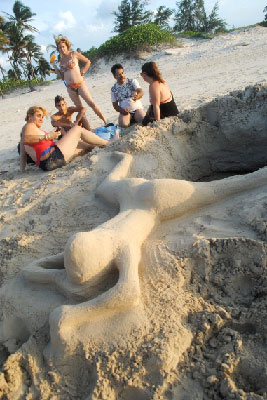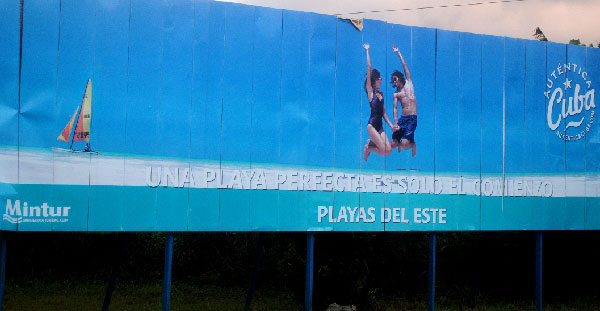Cuba: “A Perfect Beach is Just the Beginning”
Erasmo Calzadilla (Photos: Irina Echarry)
HAVANA TIMES — Children love the beach. Years ago, I took a rather enjoyable trip to one named Jibacoa, located in what was formerly referred to as “Habana campo” (“the Havana countryside”). It looked like a paradise for children.
Every morning, a fleet of large, old American-made trucks loaded with bathers from nearby towns would arrive at the coast. Though people arrived in tightly-packed groups, no one was drunk or agitated.

Almost immediately, mothers would set up camp in the shade afforded by the seagrape trees, setting up patio chairs and recliners, spreading blankets over the sand, and laying out thermoses, water bottles, dishes, cutlery, beach umbrellas and a long list of such items. The children would dart off to the crystal-clear waters and then bask in the clean sand.
At noon, it was time for a family lunch, with re-heated homemade food, and a quick nap under the sun. It looked like a bucolic scene taken right out of a painting – a way of enjoying the beach that was entirely different from life in the city.
Let’s start with city transportation. People who catch the bus to Guanabo (a coastal town near Havana), packed in like sardines, are often drunk, festive and agitated. Brawls are so frequent that bus-queues are controlled by the police, if you can believe it. Even so, things often heat up and blood is spilt in this popular omnibus.
Of course, the violence doesn’t end on the road. It heads to the sea, which does not quite manage to wash it away with its frothy, not-so-clean waves. For many, knives and bottles of cheap rum come first on the list of beach items, before sunblock and towels. Summer’s only just started and I’ve already heard of several violent beach brawls and seen the commotion surrounding a bloody confrontation.

This violent atmosphere gives the beach the appearance, not of a place where the family goes to a spend a quiet day of rest, but of a party thrown by a tough crowd from a bad neighborhood, where raeggueton blares from loudspeakers, huge amounts of alcohol and nicotine are consumed and bodies and genitals are flaunted. It is a hardcore estrogen and testosterone fest.
The sand is often dirty and it is not uncommon to cut oneself with the shards of a broken bottle. Finding a spot where one can shield oneself from the midday sun is quite a feat. There are those who plan ahead and take food from home, but most have to content themselves with the only junk food available: pizza and soft drinks.
What of the quality of the water itself? Highly dubious. From the Havana Bay area to the coast of Guanabo, there are numerous areas that are unfit for human use. Hardly anyone knows this because there are no warning signs anywhere, but several (poorly divulged) scientific reports attest to it (see my notes).
So, now you know: if you want to clear your head, relax a bit and wash away your stress with a refreshing dip, bear in mind you might return from these city beaches more agitated, tense and dirty than you were before, soaked in sewage and heavy metals and pumped full of cholesterol, kerosene, nicotine, ear-splitting noise, ultraviolet radiation and, most of all, plain old violence.
Children love the beach, but you really ought to think twice before exposing them to such abuse.
—–
Notes:
*The title is taken from the banners set up by the Cuban Ministry of Tourism to advertise the Havana’s Playas del Este (“Eastern Beaches”)
*Below are some excerpts from chapter 2 of the Cuban environmental report (“Evaluación del medio ambiente cubano”) published by Geocuba in 2009:
- During the summer, some areas, chiefly within Guanabo, Boca Ciega and the mouth of the Itabo river, experience considerable deterioration and the quality of their waters can make them unsuited for primary human contact, as per the Cuban Norm on the Bacteriological Quality of Waters for Direct Human Contact (fecal coliforms ? 2.0 x 102).
- From a sanitary perspective, the mouth of the Almendares river, the entry area of the Havana Bay, the El Chivo beach and the Alamar beach area, showed concentrations higher than the limit established by the Cuban Norm, and are thus unsuited for swimming.
- Other rivers, such as the Bacuranao, have also been contaminated by residual substances produced by agricultural activities.
- The entire littoral region shows evidence of heavy metal and hydrocarbon contamination, particularly in the form of surface sediments. The most severely affected areas are the El Chivo beach, San Lazaro Coast, the mouth of the Almendares river and, to a lesser degree, the mouth of the Guanabo river.
- The stretch of coast most severely affected by kerosene aggregates (tar balls) is the Megano-Boca Ciega section, evincing an annual mean higher than the limit established for “clean” beaches (10 g.m-1). It is followed by the Boca-Ciega Guanabo, Veneciana-Rincon de Guanabo and the Bacuranao-Tarara coastal stretches.
- [Outskirts of El Chivo beach] Surface sediments found in the area where samples were collected showed chronic contamination by oil and heavy metals, particularly copper, lead and zinc. Bioaccumulation of these metals was detected in organisms from the area studied.
Click on the thumbnails below to view all the photos in this gallery. On your PC or laptop, you can use the directional arrows on the keyboard to move within the gallery. On cell phones use the keys on the screen.




















Pity you can never visit beaches in other countries!
Hope you are happy with spending your life (forever-no exceptions)
on one island..
Is because the eastern beaches are the closest and most popular beaches to Havana, while relatively less people visit Varadero. And yes, they DO pay people to keep Varadero clean, while there is little economic incentive in keeping the eastern beaches in the same condition.
If you enjoy the eastern beaches, my favorite spot is in front of Hotel Itabo, just across the iron bridge. Is comparatively less accessible than Santa Maria and Guanabo so usually is less crowded and the beach itself is in very good shape. Or at least it was the last time I went there (5 years ago)
In general, I don’t find the police presence intrusive, and they do serve a purpose there (during the day there is plenty of illegal stuff going on and after dark pretty much anything goes).
Why are the beaches of Playa del Este always so dirty and Varadero relatively clean? Is it because the Castros clean the tourists beaches and leave the local beaches to fend for themselves? Are tourists more respectful of Cuban beaches than Cubans are? I don’t hesitate to enjoy the comforts of the tourists resorts in Varadero but I much prefer to spend my time in Cuba with regular Cubans. If I wanted to hang out with pot-bellied lecherous old Europeans, I would go to Europe. But the increasing incivility of the local beaches and the oppressive police presence that goes along with it make my trips to Playa Azul (in front of the Hotel Tropicoco), for example, less and less enjoyable.